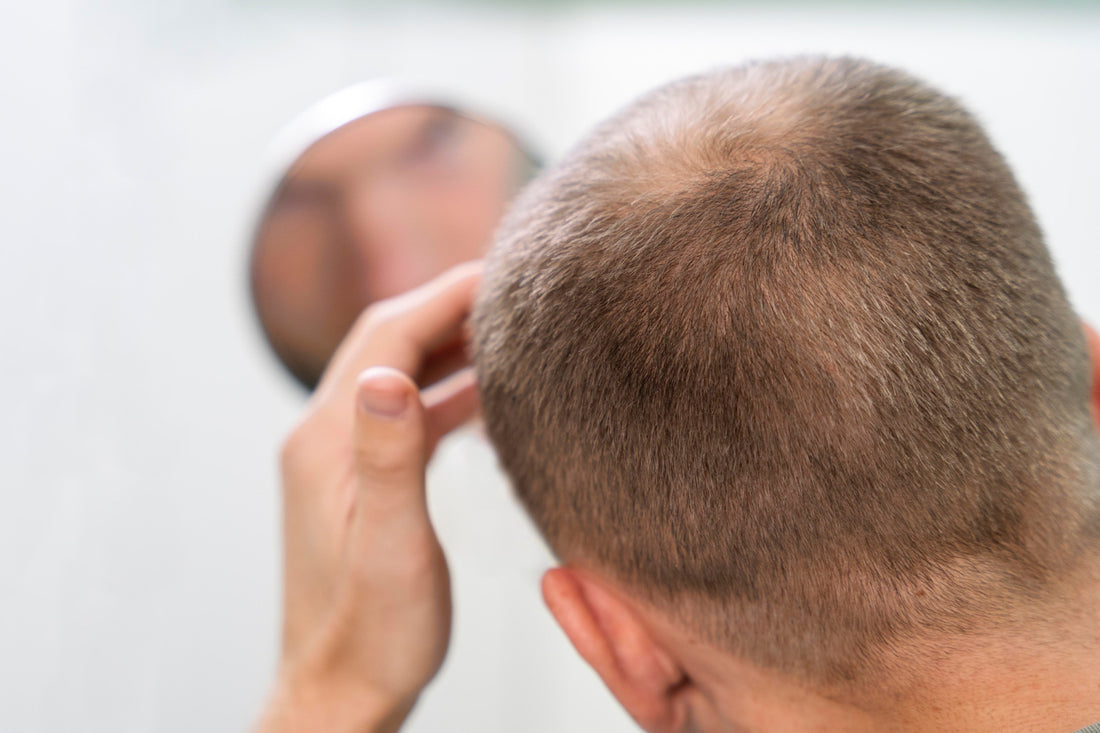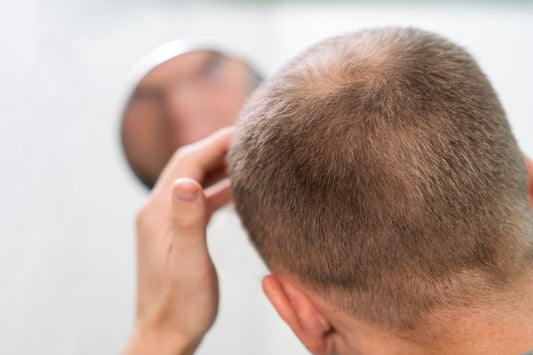Hair is an integral part of our appearance, a symbol of personal style and self-expression. Therefore, male-pattern baldness, also known as androgenetic alopecia, can profoundly impact those who experience it, influencing self-esteem and mental health.
Male pattern baldness is the most common type of hair loss in men, affecting about half of all men by the age of 50 and up to 80% by the age of 70. It typically begins with hairline recession at the temples and thinning at the crown and progresses over time to form a typical "M" or "U" shape.
This comprehensive guide aims to help individuals understand male pattern baldness and strategise an effective approach towards managing this condition.
Understanding Male Pattern Baldness
Male Pattern Baldness (MPB), clinically known as androgenetic alopecia, is primarily caused by genetic factors and hormonal influences.
The hormone dihydrotestosterone (DHT) plays a vital role. DHT is synthesized from testosterone by the enzyme 5-alpha reductase. Persons with MPB have hair follicles that are genetically sensitized to DHT. This hormonal interaction leads to gradual shrinkage of the susceptible follicle.
Over time, continual reduction of the follicle's growth phase results in finer, shorter hair until finally, the hair follicles become dormant, ceasing hair production altogether.
Identifying Male Pattern Baldness
Determining male pattern baldness against other forms of hair loss can be somewhat challenging, due to the multitude of reasons for hair loss ranging from stress, certain illnesses, to side effects from various medications.
Notwithstanding, when hair loss follows a typical pattern such as receding hairline commencing at the temples and thinning at the crown of the head, it's likely due to MPB.

To further complicate matters, these patterns can also variate from person to person, making self-diagnosis tricky. Consequently, it's essential to seek professional diagnosis. A seasoned healthcare professional, preferably a dermatologist, will be adept and well-equipped to confirm the diagnosis of MPB.
They will typically take into account other salient factors such as family history of hair loss, the individual's age, and overall health condition to make an accurate diagnosis.
Dealing with Male Pattern Baldness: A Comprehensive Strategy
To manage MPB, there is no one-size-fits-all approach that works for everyone. As such, a comprehensive treatment plan should be tailored to each person's unique needs and desires. Let's discuss a few strategies you can use.
Medical Treatments
Several FDA-approved treatments can slow down hair loss and promote hair growth:
- Minoxidil (Rogaine): An over-the-counter topical medication often used as the first line of treatment for male pattern baldness. Regular, twice-daily application can slow hair loss and stimulate hair growth. However, it may take several months of consistent use to see noticeable results.
- Finasteride (Propecia): A prescription medication that curbs DHT production. By doing so, it slows hair loss and can even cause some hair regrowth.
- Dutasteride (Avodart): Similar to finasteride, dutasteride blocks DHT but is not approved by the FDA for treating hair loss. However, some studies suggest it may be more effective than finasteride.
It's important to remember that while these treatments can be effective, they are not cures. Their effect persists only as long as they are being used. It's advisable to discuss the benefits and potential side effects of these medications with a healthcare provider.
Surgical Treatments (Hair Transplantation)
In hair transplantation, a dermatological surgeon moves hair from a hair-filled section of the head to a bald or balding part. Two methods are used: follicular unit transplantation (FUT) and follicular unit extraction (FUE).

Both have shown success in treating hair loss, and the choice often depends on individual circumstances and preferences.
In FUT, a section of skin is removed from the back of the scalp and cut into tiny, round grafts containing one to four hairs per graft. These are then transplanted into balding areas.
In FUE, a small punch tool is used to remove individual hair follicles from the donor area (usually the back or sides of the head) in groups of one to four hairs each. This is a newer method, and it typically takes longer than FUT. However, the grafts look more natural because they don’t have scars or holes left behind in the donor area.
Lifestyle Modifications
Certain lifestyle modifications can potentially slow hair loss and improve overall hair health:
- Avoidance of harmful hair practices: Practices such as using hot styling tools, chemically treating hair, or tying hair tightly can damage hair and exacerbate hair loss.
- Healthy diet: Eating a balanced diet rich in protein, vitamins (especially A, D and E), iron, and omega-3 fatty acids can promote healthier hair.
- Exercise and stress management: Regular exercise can help balance hormone levels and promote overall health, which may slow hair loss. In addition, since stress can contribute to hair loss, stress management techniques such as mindful meditation, yoga, or counseling can be helpful.
Acceptance and Adaptation
Coming to terms with hair loss could be a major part of dealing with male pattern baldness. This journey can be distinctly unique and personal, having its own set of challenges.
However, adopting an empathetic and patient approach towards oneself during this process can be profoundly impactful. Counseling or support groups can offer emotional support and practical advice.
Adapting to hair loss can also mean embracing a new appearance. Some men opt for short haircuts or shaven heads, while others choose to wear hats or scarves or explore options like wigs or hairpieces.
Conclusion
Facing male pattern baldness requires a well-rounded approach that includes medical treatments, lifestyle changes, and ways to cope emotionally.
Hair loss is a personal journey that can stir up many different feelings, from frustration to coming to terms with it. But, the most important thing is to accept yourself, hair or no hair.
With the right tools and support, anyone dealing with male pattern baldness can work towards accepting themselves while also taking practical steps to manage their hair loss.
Looking for a simple way to keep your hair strong and healthy? Try the Mohebi Life Natural Hair Support Supplement for Men. A single capsule every day can let you benefit from our science-backed formula.
Our supplement uses pure, effective ingredients like saw palmetto and pumpkin seed oil. These have been shown in five separate studies to support healthy hair growth and make hair better in quality. So, start your adventure towards better hair with Mohebi Life.
FAQs
Can you really stop male pattern baldness?
While you can't completely stop male pattern baldness as it's largely genetically determined, there are treatments available, like minoxidil and finasteride, that can slow hair loss and even promote some hair regrowth.
What is the most effective way to stop male pattern baldness?
The most effective way to manage male pattern baldness involves a combination of medical treatments (like minoxidil or finasteride), proper nutrition, and avoiding harmful hair treatments. A balanced diet and regular exercise can also contribute positively.
Why is male pattern baldness good?
While male pattern baldness is typically viewed negatively due to aesthetic reasons, it's not harmful or bad for your health. In fact, certain studies suggest that men with male pattern baldness may have a lower risk of developing testicular cancer.
Will I go bald if my dad is?
Male pattern baldness is polygenic, meaning it's determined by several genes. If your father is bald, it increases your likelihood of experiencing hair loss, but it's not a guarantee as genes from both parents contribute.
At what age do men start balding?
Male pattern baldness can start as early as the teenage years, but most commonly starts in the early 20s to 30s. By age 50, about half of all men will experience some degree of hair loss.



